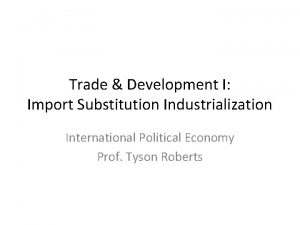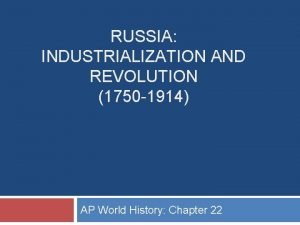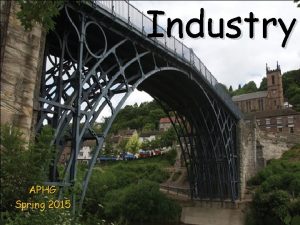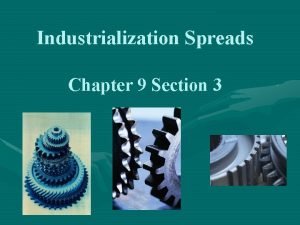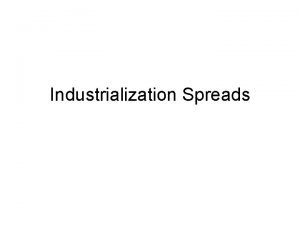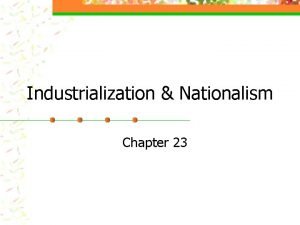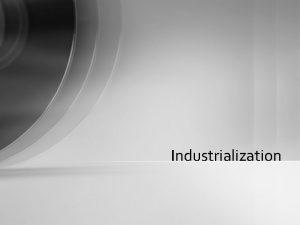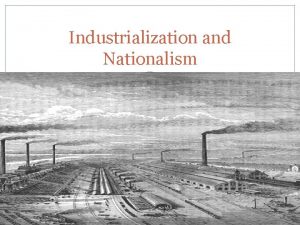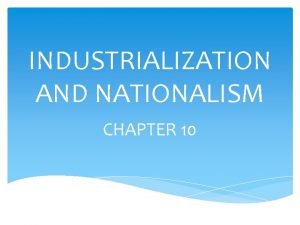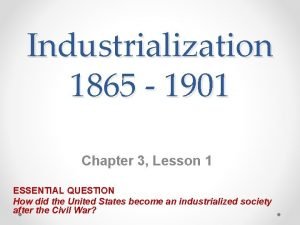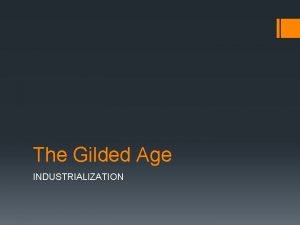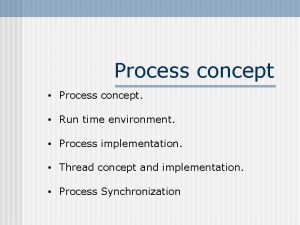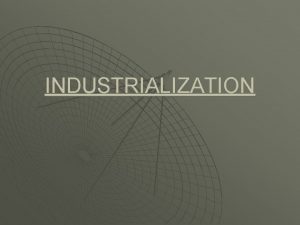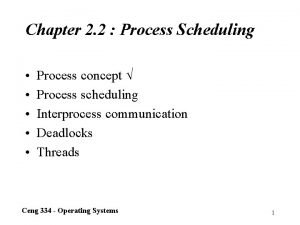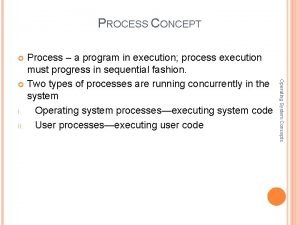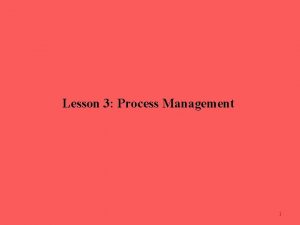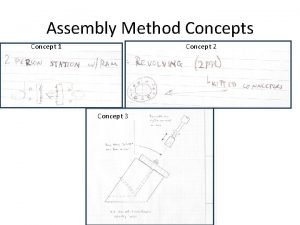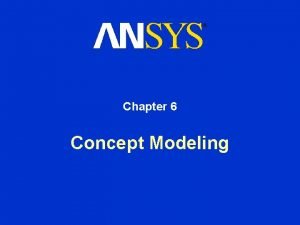INDUSTRIALIZATION CONCEPT 5 1 Industrialization is a process













- Slides: 13

INDUSTRIALIZATION CONCEPT 5. 1

• Industrialization is a process that transformed agrarian and hand-crafted economies into economies distinguished by industry and machine manufacturing. Inanimate sources of energy such as coal and petroleum made it possible to mass produce goods by machines rather than slowly by hand. But any time the term “Industrial Revolution” is used, remember, that it was actually a gradual event occurring over the 18 th and 19 th century and then eventually becoming global. WHAT IS INDUSTRIALIZATION?

• High agricultural productivity and high population densities were common features of industrialized societies. Rising food surplus and rising population permitted individuals to work at tasks beside farming. “The need for raw materials for the factories and increased food supplies for the growing population in urban centers led to the growth of export economies around the world that specialized in mass producing were used to purchase finished goods. ” (AP World History Curriculum Framework. IIA) • Other features of industrialized societies included, sophisticated banking and financial institutions as well as facilitated trade and transport. FOUNDATIONS OF INDUSTRIALIZATION:

• In Great Britain, coal played a crucial role on their (GB) path to industrialization. Up until the 18 th century wood was the main source of fuel for iron production, cooking, and heating. But by the end of the 17 th century serious wood shortages and geographic luck led to coal becoming the main source of fuel and a driving force for industrialization. • The introduction of “fossil fuels” greatly increased the energy available to human societies. Technological advances quickly followed the introduction of coal in the 18 th century. For example the steam engine (powered by coal) was one new invention that transformed the manufacturing industry in the 1900’s. COAL & INDUSTRIALIZATION:

• The development of machines revolutionized the work force by paving the way for factories, specialized labor, changed economies, and the rise of the manufacturing industry. • The big three of industry (at least in the eyes of this power point creator) were/are steam, cotton, and iron & steal. But within this power point we will focus on the development of the steam engine due to its direct relationship to coal and industrialization. THE MACHINE AND INDUSTRIALIZATION.

• The introduction of “fossil fuels” greatly increased the energy available to human societies. • The most crucial technological breakthrough of the early industrial era was the creation and development of a general purpose steam engine. (1765 -James Watt) These steam engines burned coal to boil water and create steam, which drove the devices that performed the work. Even before James Watt had created his steam engine, a device had been developed that could draw water out of coal mines, and that is what he based his steam engine off of. (but that steam engine was rarely used because it used up too much fuel) THE STEAM ENGINGE

• But Watt’s version used steam to force a piston to turn a wheel, whose movements allowed a single pump engine a variety of jobs and uses. (the term “horsepower” was coined to measure the energy generated in comparison to the work of animals) Eventually his (Watt’s) steam engine made its way not only into transportation (trains, steamships, etc. …) but is also drastically changed industries, such as the textile industry as greater productivity= lower prices for consumers. THE STEAM ENGINE CONT…

• The “slow and steady” rise of industrialization during the 18 th and 19 th century not only changed industries and the way we do business but also the way we as humans not only without selves but also in our environment. EFFECTS OF INDUSTRIALIZATION:

• One of the main effects of Industrialization was the radical conversion of the traditional social structure. So, before industrialization the majority of the working peoples dwelled and worked in rural areas. But the rise of industrialization caused millions of people to move to industrial centers. Industrialization encouraged the disappearance of slavery, and the creation of laborers who spent their money on products that kept their factories in work. THE CHANGE IN SOCIAL CLASSES:

• “Captains of Industry” and the business people became increasingly wealthy and powerful enough to overshadow the traditionally privileged classes. • Below the wealthy came the middle class consisting of small business owners, managers, engineers, accountants, employees of large corporations, and professionals. Who saw great wealth flow into their hands as the period of Industrialization charged on. THE CHANGE IN SOCIAL CLASSES cont… :

• Next came the laborers who worked factories and mines constituting a new working class coming straight from the creation of an industrialized society. • And finally came those less skilled than artisans and craft workers. These new workers tended to machines or provided heavy difficult labor for low wages. • Due to industrialization concentrating in mining and machinery, the working class was finally able to influence political affairs by the middle of the 19 th century. THE CHANGE IN SOCIAL CLASSES cont… :

• With the rising of factory and a new social class came trade unions. These unions sought to advance the quest for a just and equal society. While governments regulated businesses and enhanced social security, these trade unions struggled to eliminate the abuses of early industrial society and improve the lives, working conditions, and pay of their members. Throughout much of the 19 th century the government considered these trade unions illegal associations whose goal was to restrain and damage trade. Over time trade unions gradually improved the lives of working people and reduced the chances that an unsatisfied work force would mount a revolution to destroy the industrial capitalistic society. And eventually trade unions became an integral part of society due to the fact that they were not seeking to destroy capitalism but rather to make employers more responsive to their employees’ needs. TRADE UNIONS:

• Industrialization is a process that transformed agrarian and hand-crafted economies into economies distinguished by industry and machine manufacturing over the 18 th and 19 th centuries that eventually hit the global scale while changing the way people interacted. OVERALL
 Ideal self vs. real self
Ideal self vs. real self Contoh marketing concept
Contoh marketing concept Import substitution industrialization
Import substitution industrialization Industrialization causes
Industrialization causes Russian revolution of 1905 definition ap world history
Russian revolution of 1905 definition ap world history What is outsourcing aphg
What is outsourcing aphg Industrialization spreads chapter 25 section 3
Industrialization spreads chapter 25 section 3 Industrialization spreads
Industrialization spreads Chapter 9 section 3 industrialization spreads answer key
Chapter 9 section 3 industrialization spreads answer key Industrialization and nationalism
Industrialization and nationalism Footloose industry
Footloose industry Industrialization and nationalism worksheet answers
Industrialization and nationalism worksheet answers Chapter 10 industrialization and nationalism
Chapter 10 industrialization and nationalism Chapter 3 industrialization (1865 to 1901 answers)
Chapter 3 industrialization (1865 to 1901 answers)


